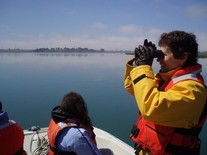EARTHWATCH KIDS
Otter Challenges and Successes (Kids & Parents)
Sunday, August 3, 2008

Along the beautiful coast here in Monterey Bay, a large number of otters live right here in Elkhorn Slough (remember, it's the wetland, or estuary area, between the land and the sea). In my field work here with Earthwatch Institute, I've also discovered that southern otters spend a good amount of time in Moss Landing's North Harbor, and directly offshore, where eel grasses provide foraging areas for otters and seals, and other marine mammals. Recently, I observed otters in the ocean along the rocky shoreline of Monterey, a town further south on the coast, where kelp beds provide otters with shelter, security, and a plentiful supply of purple sea urchins (their favorite food)! Further north along the coast, near Watsonville, our Earthwatch team spotted otters both along the shoreline, and further out at sea, where they were sharing foraging territories with bottlenose dolphins, harbor seals, and sea lions.
The immediate area surrounding Elkhorn Slough is protected from development, which undoubtedly is why Dr. Daniela Maldini's Earthwatch teams have observed increasing numbers of otters living in this unique habitat during certain years. But there are varying trends to the otter population (there have been population declines, as well), and understanding these trends is just one of Daniela's objectives as the Principal Investigator for Earthwatch's ongoing work in Moss Landing. Dr. Maldini, working with her Project Coordinator, Mark Cotter, dedicated local volunteers, and skilled marine scientists, has been able to accumulate consistent data on the southern otter since 1994. The years when otter populations have been observed to be increasing here in Elkhorn Slough (1994 to 1998 is one period, and 2003 to 2007 is another), the data is not in yet for 2008), could certainly be interpreted as a paradox of sorts. After all, this is an area where commercial fishing is a dominant feature of the coastal economy, a place where boaters of all kinds launch and dock their vessels, and where sediment runoff from adjacent agricultural fields impact marine sediments (and, in turn, the marine food supplies for otters) with pesticides, fertilizers, and other toxins (to be discussed in later blog posts). And, yet, perhaps because of the measures taken to protect wildlife in Elkhorn Slough, and perhaps because of changes in otter food supplies further out in Monterey Bay, many otters have demonstrated recently that this small but important location on the central Monterey coastline may be their preferred primary residence, or at the very least, a resting and/or recuperation zone. Female otters typically give birth to their baby pups here (in the Slough), otter rafts, comprised primarily of male otters, hang tight here (primarily in the North Harbor), and the harbor jetty is a popular place for daily foraging, as tidal shifts within the harbor entrance deliver fresh supplies of rock crabs, littleneck clams, yellow shore crabs, moon snails, Washington clams, striped shore crabs, and Pacific gapers. An invasive species of green crab has also proven to be very popular with the otters, and has to some extent replaced the once abundant, and now decreasing, supply of indigenous crab species. The otters are now benefiting from, and controlling an invasive species, which appears on the surface, at least, to be a win-win situation.
Within Elkhorn Slough, southern otters share their habitat with a magnificent array of shore birds, who also consider Moss Landing and Elkhorn Slough home. There are also harbor seals and sea lions, which appear to also have a particular affection for Moss Landing Harbor and the Slough. A morning on Elkhorn Slough, whether it is in a kayak, a canoe, or a scull, is a magical experience. The morning we were out with Ron Eby (previous post), the water was mirror-like and still, and yet so much rich ecological activity was clearly in play.
Marine biologists estimate that there are now roughly 2,800 to 3,000 southern otters living along the Monterey Bay waters, which have a carrying capacity for 16,000 otters. This means that the environment here could support many more otters, so scientists are curious about why the southern otter population is not increasing more significantly. Because of their relatively small numbers, the southern otter remains listed as a threatened species, which means that scientists, and the public need to work together to ensure their safety. If environmental conditions here in Monterey Bay were to change for the worse (for example, if drilling for oil off California's coast was authorized), the southern otters could face insurmountable environmental challenges, and perhaps, even extinction. Herein lies one very good example of the conflict presented when human development disrupts the natural balance of nature, and when that interference can have long-term, radical impacts on an otherwise diverse marine ecosystem.
One way that scientists and the public have worked together successfully to protect the southern otter is the surrogate program at the Monterey Bay Aquarium. Recently, the aquarium released into Elkhorn Slough an otter that was raised by a surrogate otter mother. The exciting news is that this past week (late July, 08) the released otter gave birth naturally to her own pup right here in Elkhorn Slough. Mother otter and baby pup are safe and secure here, where scientists, policy makers, and concerned citizens have united to protect wildlife.
For parents who are interested, the law that currently protects the southern otter population is called the U.S. Endangered Species Act, and it was passed in 1977.
I will be looking at more of the factors affecting the southern otter in future blogs.
Fun Otter Fact #6
Sea otters are the only sea mammals that move from one area to another on the surface of the water, and on their backs!
This NOAA website describes Elkhorn Slough in detail: http://nerrs.noaa.gov/ElkhornSlough
Original article can be found here: http://www.earthwatchkids.net/subBlog.asp?bID=135